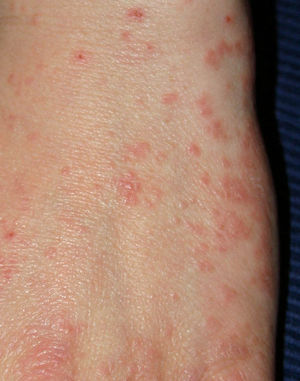What is Scabies?
Scabies is a contagious eruption of the skin. The breakout comprises small pointed vesicle. It initially appears between the fingers, on the wrists, feet, male genitalia, inside the joints, and on such parts of the body where the texture of the skin is thin.
Gradually it spreads all over the body surface, excepting the skull and the face, which are rarely affected. The disease may be widespread, or remain localized at a small portion of the body surface. The vesicles generally do not get clustered. These contain small amounts of a transparent fluid. The intense desire for itching, add the discomfort of this ailment.
Symptoms of scabies:
The diagnosis of Scabies is often very difficult because its symptoms can be readily be erroneously taken for those of other itchy skin conditions, like eczema. Nevertheless, the foremost and the most common symptom of scabies is itching, especially at night.
Swellings that are red in color and resemble tiny insect bites or pimples also emerge. As the condition worsens, the skin may become crusty or scaly — particularly around the fingers, wrists, ankles, buttocks, waistline, nipples and penis. In children, the infestation can occur all over the body, especially on the soles, palms, and scalp.
The causative organism of scabies: It is a small insect Sarcoptes scabiei. The female mite burrows into the skin, very close to the vesicle. In certain cases pustules, filled with a yellow matter, develop. A tiny meandering blister develops following the path that the mite traces as she lays her eggs.
After a few weeks, the affected individual shows an allergic response to the mite and its eggs. This results in severe itchiness and rosiness at the site. If left untreated, the eggs hatch and new mites come up and take the cycle forward. The mites that give rise to scabies are very persnickety.
They want warm body temperature to thrive. For this reason, transmission of scabies necessitates prolonged physical contact. When the conditions are optimum, scabies can exceptionally infectious and can be contaminated by close contact with an infected person.
It can take more than a month before an affected individual recognized the signs of an infection, especially if the person maintains good hygiene has at all times and takes regular baths. So it is possible that the sufferer already transmits the disease to those coming into contact with him even before it is detected.
The disease, if not provided with medial attention, shows no tendency of abating but continues for indefinite periods.
Treatment:
Sulphur I the principal remedy for scabies. It may be taken internally or applied externally. Internal remedies alone may fail to eliminate the insect that causes scabies, especially when used in low dilutions.
Application of Sulphur at the early stages of the disease is admissible and actually beneficial. The Sulphur should be administered in a dose of thrice a day for about two weeks. External application of some specially formulated scabies-treating ointment should also be continued.
If even after two weeks, the symptoms are not allayed, Mercurius viv. should be given once at night and again in the morning, for ten days, followed by Carbo veg. for ten more days, and ultimately, Hepar sulphuris needs to be employed.

